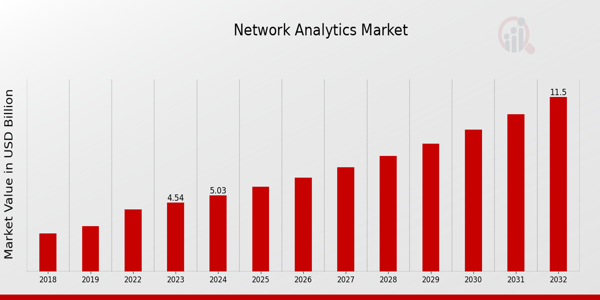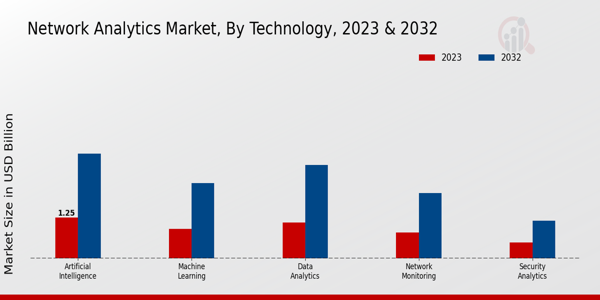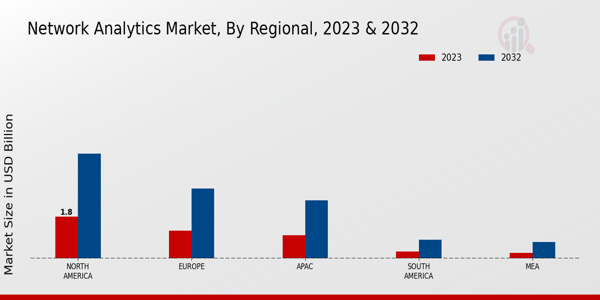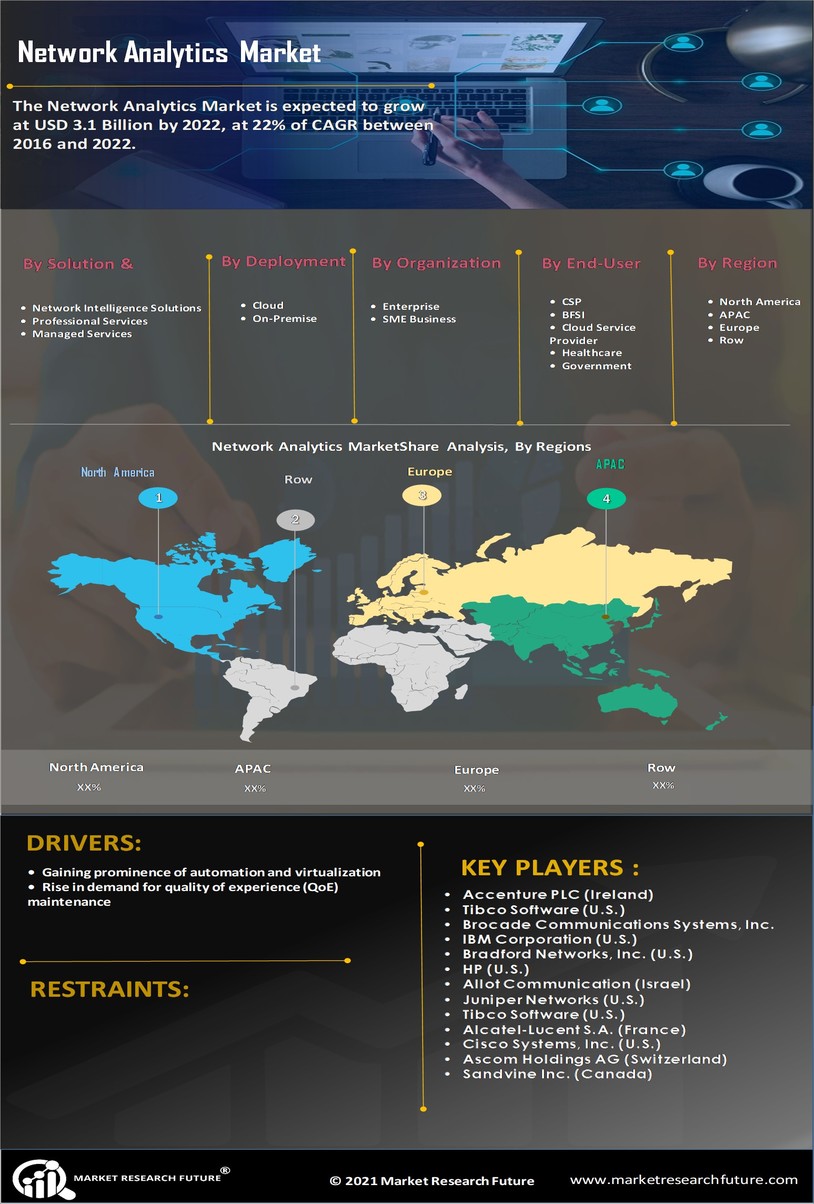Network Analytics Market Overview
As per MRFR analysis, the Network Analytics Market Size was estimated at 4.09 (USD Billion) in 2022.The Network Analytics Market Industry is expected to grow from 4.54(USD Billion) in 2023 to 11.5 (USD Billion) by 2032. The Network Analytics Market CAGR (growth rate) is expected to be around 10.89% during the forecast period (2024 - 2032).
Key Network Analytics Market Trends Highlighted
The Global Network Analytics Market is experiencing notable growth driven by increasing data traffic and the rising complexity of network systems. Organizations are increasingly relying on network analytics to enhance performance, improve security, and optimize resources. This needs for better visibility into network operations and user behaviors pushing businesses to adopt advanced analytics solutions. Additionally, the proliferation of Internet of Things (IoT) devices is generating massive amounts of data, creating a demand for solutions that can manage and analyze this information effectively.
By leveraging network analytics, organizations can anticipate issues before they become critical, ensuring seamless connectivity.Opportunities in the Global Network Analytics Market are abundant, particularly in sectors where data integrity and security are critical.
Industries such as healthcare, finance, and telecommunications are ideal candidates for the implementation of advanced network analytics solutions. These sectors can benefit significantly from identifying patterns and anomalies that may indicate security breaches or system inefficiencies. More businesses across various sectors are recognizing the economic and operational advantages that come with implementing smart analytics tools. Moreover, advancements in artificial intelligence and machine learning are set to further refine analytics capabilities, making it easier for organizations to gain insights promptly.Recently, trends such as the increased integration of AI and machine learning into network analytics are reshaping the market landscape.
Companies are looking to adopt real-time analytics tools that provide immediate insights for proactive decision-making. Cloud-based analytics solutions are also gaining traction, as they offer scalability and flexibility that traditional systems cannot match. The shift towards remote work has heightened the focus on network performance and reliability, encouraging investment in robust analytics solutions to support distributed working environments. As the market evolves, organizations that prioritize these technologies will likely find themselves at a competitive advantage.Overall, the Global Network Analytics Market is poised for significant evolution, influenced by technological advancements and a growing emphasis on data-driven decision-making.
Fig 1: Network Analytics Market Overview

Source: Primary Research, Secondary Research, Market Research Future Database and Analyst Review
Network Analytics Market Drivers
Increasing Demand for Real-Time Network Monitoring and Management
The increasing need for real-time network monitoring and management is a primary driver of growth in the Global Network Analytics Market Industry. As organizations become more reliant on networked systems for their operations, the demand for tools that can provide immediate analysis of network performance and security has surged. This is driven by the exponential growth of data generated by connected devices, the rise of IoT and an increasing number of users accessing networks and applications simultaneously.Many enterprises are recognizing that traditional monitoring approaches are no longer sufficient to handle the complexity and volume of data traffic on modern networks.
They require advanced analytics solutions that can provide insights into network behavior in real-time, enabling them to quickly address issues such as latency, bottlenecks, and potential security threats. By implementing network analytics, companies can gain valuable insights into network usage patterns, optimize performance, and ensure reliable service delivery to customers.The need for enhanced operational efficiency is also a significant motivator, as organizations seek to optimize their resources while minimizing downtime and disruptions.
Furthermore, with the transition to hybrid and cloud environments, there is an increasing necessity for sophisticated network analytics tools that can analyze data across multiple environments and provide a unified view of network performance. These capabilities are crucial in maintaining business continuity and supporting digital transformation initiatives.Therefore, the increasing requirement of having real time information and control over networks is one of the most important growth factors for the Global Network Analytics Market.
Growing Importance of Cybersecurity
The rising importance of cybersecurity is another significant driver for the Global Network Analytics Market Industry. As cyber threats become more sophisticated and prevalent, organizations are increasingly investing in network analytics to enhance their security posture. These analytics tools enable enterprises to detect anomalies, identify potential vulnerabilities, and respond proactively to cyber threats, thereby safeguarding sensitive information and maintaining compliance with regulatory requirements.With the number of connected devices skyrocketing, companies realize that traditional security measures are insufficient to protect against emerging threats.
Network analytics provides deep insights into network traffic patterns, allowing security teams to establish baseline behaviors and identify deviations that may indicate security incidents.
Rapid Growth of Big Data and IoT
The rapid growth of big data and the Internet of Things (IoT) is transforming how organizations leverage data for decision-making, subsequently boosting demand in the Global Network Analytics Market Industry. As more devices connect to networks and generate immense volumes of data, organizations need advanced analytics solutions that can help them process and analyze this data swiftly and effectively.
Network analytics assists businesses in extracting actionable insights from big data, enhancing their ability to make data-driven decisions and optimize their network infrastructures.Understanding traffic patterns, user behaviors, and device interactions allows organizations to improve their operational strategies and enhance overall network performance.
Network Analytics Market Segment Insights
Network Analytics Market Technology Insights
The Global Network Analytics Market, particularly within the Technology segment, is poised for noteworthy growth, with the overall market expected to reach a valuation of 4.54 USD Billion by 2023. This sector focuses on optimizing network performance and security through various technological advancements. Within this landscape, Artificial Intelligence is a significant contributor, holding a valuation of 1.25 USD Billion in 2023 and projected to increase to 3.2 USD Billion by 2032, showcasing its pivotal role in predictive analytics and automation.
Machine Learning follows closely, reflecting its importance in data modeling and analysis, valued at 0.9 USD Billion in 2023 and expected to grow to 2.3 USD Billion by 2032.
Data Analytics, also critical in interpreting vast amounts of network data, is valued at 1.1 USD Billion currently, with a future value of 2.85 USD Billion, highlighting the escalating demand for actionable insights in network management. Network Monitoring focuses on ensuring system reliability and performance, currently valued at 0.8 USD Billion, indicating its essential role in proactive network management, forecasted to reach 2.0 USD Billion by 2032.
Security Analytics is essential in addressing threats and vulnerabilities, currently valued at 0.49 USD Billion, with an anticipated growth to 1.15 USD Billion, underscoring increasing concerns regarding cybersecurity. The trend towards interconnected devices and the expansion of digital infrastructure are key growth drivers, forcing organizations to adopt sophisticated network analytics solutions that can offer real-time insights and enhance decision-making processes.
Major challenges in the market include the integration of diverse data sources and managing the complexities of modern network architectures. However, the clear opportunity lies in developing AI and machine learning-driven solutions for advanced data analysis, which could dominate the Global Network Analytics Market. Hence, this Technology segment reflects a robust future trajectory, driven by the value contributions of its various components, as organizations increasingly leverage these technologies for enhanced network performance and security.
Fig 2: Network Analytics Market Insights

Source: Primary Research, Secondary Research, Market Research Future Database and Analyst Review
Network Analytics Market Deployment Mode Insights
The market is currently segmented into deployment modes such as On-Premises, Cloud and Hybrid. The On-Premises deployment mode, characterized by local installations, has been historically significant for organizations prioritizing data security and control of their network environments. Meanwhile, the Cloud deployment mode has gained traction due to its flexibility and cost-effectiveness, enabling businesses to scale their network analytics capabilities seamlessly.The Hybrid model merges both On-Premises and Cloud solutions, allowing enterprises to optimize their operations by leveraging the advantages of both methodologies.
As the Global Network Analytics Market continues to evolve, emerging trends favoring automation, increased data flow, and the growing need for real-time analytics are driving the expansion of the market, presenting high growth opportunities, while challenges such as integration difficulties remain. The Global Network Analytics Market statistics reveal a well-rounded market landscape that is aligning with technological advancements and changing user preferences.
Network Analytics Market Application Insights
Key areas within this segment, such as Network Performance Management, play a crucial role in ensuring optimal network functionality and supporting organizations in identifying and resolving issues swiftly. Network Security has emerged as an essential focus, driven by increasing cyber threats, thus necessitating advanced analytics to safeguard critical data and maintain the integrity of operations.Additionally, Traffic Management is gaining prominence as businesses seek effective monitoring solutions to optimize bandwidth utilization. Lastly, User Experience Management significantly influences customer satisfaction, enabling operators to tailor experiences based on analytics-driven insights.
As globalization and digital transformation continue, the market exhibits substantial growth potential, with the underlying trends pointing towards an increased reliance on data-driven decision-making processes across industries. The emphasis on real-time analytics in the above applications is a crucial factor in the market's evolution, addressing the challenges of increased network demands and enhancing operational capabilities for diverse businesses.
Network Analytics Market End Use Insights
The End Use segment plays a crucial role in shaping this trajectory, encompassing various industries such as Telecommunications, BFSI, Healthcare, IT Telecom, and Retail. Telecommunications stands out as a significant contributor, driven by the need for enhanced network performance and reliability. The BFSI sector increasingly utilizes network analytics to mitigate risks and provide better services to customers, indicating its importance in maintaining customer trust.Healthcare organizations leverage network analytics for improved patient care and operational efficiency, showcasing its necessity in navigating complex data environments. The IT Telecom sector continues to adapt, focusing on managing vast data flows effectively.
Retail businesses increasingly rely on network analytics to enhance customer experiences and streamline operations. Each of these sectors is critical to the overall dynamics of the Global Network Analytics Market, reflecting diverse requirements and opportunities that fuel market growth.The trends show a robust demand for analytics solutions driven by the desire for efficiency, security, and enhanced customer satisfaction across these varied industries.
Network Analytics Market Regional Insights
North America holds a significant position, valued at 1.8 USD Billion, highlighting its majority holding in the market. Europe follows, valued at 1.2 USD Billion, showcasing its importance through strong demand for network analytics solutions. The APAC region is valued at 1.0 USD Billion and is recognized for its increasing technological adoption and robust growth potential, while South America, with a value of 0.3 USD Billion, reflects nascent opportunities in network analytics.The Middle East and Africa, valued at 0.24 USD Billion, signify emerging markets that are beginning to embrace network analytics for improved efficiency and decision-making.
Overall, the Global Network Analytics Market data shows that North America and Europe dominate the industry, largely driven by advancements in technology and the need for enhanced network performance across sectors. As the demand for data-driven insights grows, market growth is on a positive trajectory across all regions, offering opportunities for existing and new players in the industry.
Fig 3: Network Analytics Market Regional Insights

Source: Primary Research, Secondary Research, Market Research Future Database and Analyst Review
Network Analytics Market Key Players and Competitive Insights
The Global Network Analytics Market is experiencing remarkable growth as organizations seek to enhance their network performance, security, and overall operational efficiency. This market comprises a variety of players who offer solutions that leverage data analytics to provide insights into network usage, traffic patterns, and potential issues. Competitive dynamics in the market are shaped by technological advancements, the rising demand for real-time monitoring, and the increasing trend of digital transformation across industries. Companies that operate within this space continuously innovate their offerings and strengthen their market presence through strategic partnerships, mergers and acquisitions, and a focus on customer-centric solutions.
The landscape is marked by a blend of established players and emerging companies aiming to carve out distinctive niches by addressing the diverse needs of network management and analytics.NetScout Systems has established itself as a significant player in the Global Network Analytics Market, known for its immense expertise in providing comprehensive network and service assurance solutions. The company stands out due to its robust analytics capabilities that allow organizations to gain deep insights into their network performance and user experiences.
With a strong emphasis on enhancing visibility across diverse IT environments, NetScout Systems is recognized for its advanced threat detection and traffic analysis features. The company’s ability to deliver actionable intelligence from complex network data helps organizations make informed decisions and optimize their operational efficiency. Its strong market presence is supported by its portfolio of high-quality products and services designed to meet the evolving demands of businesses striving for excellence in network performance. HPE has carved out a noteworthy niche in the Global Network Analytics Market through its innovative solutions designed to transform network performance and enhance decision-making processes.
The company focuses on integrating advanced analytics into its networking infrastructure, leveraging machine learning and big data capabilities to provide real-time insights and predictive analytics. HPE's commitment to delivering intelligent edge solutions positions it favorably as organizations increasingly recognize the critical role of analytics in network management. The company’s strengths lie in its ability to provide scalable solutions that cater to diverse industry needs, coupled with a reputation for reliability and performance. Its strategic approach towards enhancing customer experience through constant innovation and the development of next-generation networking technologies establishes HPE as a formidable competitor within this growing market segment.
Key Companies in the Network Analytics Market Include
- NetScout Systems
- HPE
- Nokia
- Atlassian
- Palo Alto Networks
- Oracle
- SAP
- Dynatrace
- Splunk
- Cisco Systems
- Microsoft
- IBM
- Juniper Networks
- Centrica
- Broadcom
Network Analytics Market Industry Developments
In September 2023, Ericsson rolled out its Ericsson Expert Analytics product. Its main feature is advanced problem handling via AI and machine learning in order to analyze data from the telecom network. The product also boasts troubleshooting tools such as fault localization.
In August 2023, TPG Telecom inked a partnership with Ericsson that aims to deliver cloud-native and Artificial Intelligence (AI) analytics tools for bettering the performance of the network. This partnership will allow TPG Telecom to extract value from its fixed wireless access, mobile with 4G & 5G, and Internet of Things (IoT) subscribers in a more intelligent way with improved data collection.
In August 2023, SK Telecom Co. rolled out an analytics solution and simulator for Urban Air Mobility (UAM) communication networks. The system incorporates drones which act out UAM vehicles’ real-time communications.
In May 2023, Juniper Networks, Inc. Introduced the first cloud-native service dubbed Mist Access Assurance. Network access control, capability to manage policies which consist of wired, wireless, indoor, sd-WAN and secure to client to cloud portfolio now made easy with the use of Mist Ai and modern microservices cloud.
In April 2023, a venture between Google Cloud and Accenture was developed during the announcement of the two companies, stating their collaboration in enhancing asset protection and fortifying security against these foreign threats. They further emphasized how they will utilize AI, ML, and Cybersecurity to enhance their digital capabilities. Such technological approaches would be able to assist both firms in achieving their business goals.
In February 2023, Cisco announced that it is going into a deal with V.tal to increase the capacity of its neutral, multi-tenant fiber network across Brazil in order to boost the adoption of 5G services. This aims at creating a shell intended to enable the development of the Internet and increase connectivity at the national level.
Network Analytics Market Segmentation Insights
Network Analytics Market Technology Outlook
- Artificial Intelligence
- Machine Learning
- Data Analytics
- Network Monitoring
- Security Analytics
Network Analytics Market Deployment Mode Outlook
Network Analytics Market Application Outlook
- Network Performance Management
- Network Security
- Traffic Management
- User Experience Management
Network Analytics Market End Use Outlook
- Telecommunications
- BFSI
- Healthcare
- IT Telecom
- Retail
Network Analytics Market Regional Outlook
- North America
- Europe
- South America
- Asia Pacific
- Middle East and Africa
| Attribute/Metric |
Details |
| Market Size 2022 |
4.09(USD Billion) |
| Market Size 2023 |
4.54(USD Billion) |
| Market Size 2032 |
11.5(USD Billion) |
| Compound Annual Growth Rate (CAGR) |
10.89% (2024 - 2032) |
| Report Coverage |
Revenue Forecast, Competitive Landscape, Growth Factors, and Trends |
| Base Year |
2023 |
| Market Forecast Period |
2024 - 2032 |
| Historical Data |
2019 - 2023 |
| Market Forecast Units |
USD Billion |
| Key Companies Profiled |
NetScout Systems, HPE, Nokia, Atlassian, Palo Alto Networks, Oracle, SAP, Dynatrace, Splunk, Cisco Systems, Microsoft, IBM, Juniper Networks, Centrica, Broadcom |
| Segments Covered |
Technology, Deployment Mode, Application, End Use, Regional |
| Key Market Opportunities |
Increased demand for real-time insights, Rapid growth of IoT devices, Need for network security enhancements, Integration with AI and machine learning, Expansion of cloud-based solutions |
| Key Market Dynamics |
Increasing data traffic, Rising security concerns, Growing adoption of IoT, Need for operational efficiency, Enhanced customer experience |
| Countries Covered |
North America, Europe, APAC, South America, MEA |
Network Analytics Market Highlights:
Frequently Asked Questions (FAQ):
The Global Network Analytics Market is expected to be valued at 11.5 USD Billion by 2032.
The expected CAGR for the Global Network Analytics Market from 2024 to 2032 is 10.89%.
North America is projected to dominate the Global Network Analytics Market with an expected value of 4.5 USD Billion by 2032.
The AI segment of the Global Network Analytics Market is expected to reach a value of 3.2 USD Billion by 2032.
Key players in the Global Network Analytics Market include NetScout Systems, HPE, Nokia and Palo Alto Networks, among others.
The European segment of the Global Network Analytics Market is expected to grow to a value of 3.0 USD Billion by 2032.
The Security Analytics segment of the Global Network Analytics Market is expected to reach a value of 1.15 USD Billion by 2032.
The APAC region is expected to reach a market value of 2.5 USD Billion by 2032 in the Global Network Analytics Market.
The Machine Learning segment of the Global Network Analytics Market was valued at 0.9 USD Billion in 2023.
The Network Monitoring segment is projected to grow to a value of 2.0 USD Billion by 2032.


















